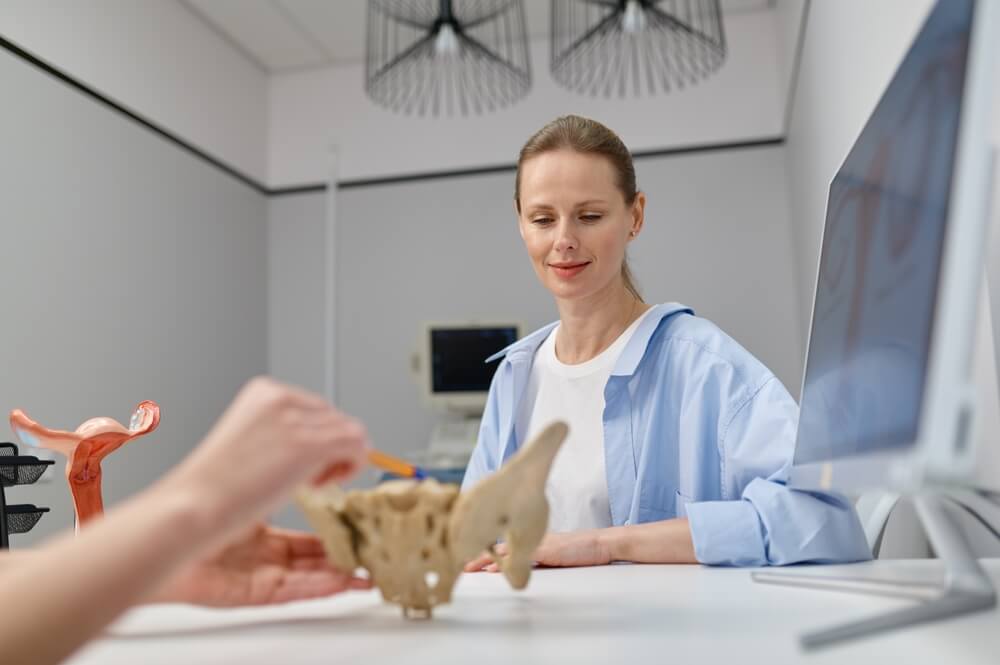Women’s health is a complex and multifaceted domain, and one area that demands attention is the pelvic floor. Pelvic floor disorders, encompassing conditions such as pelvic organ prolapses and stress urinary incontinence, are prevalent yet occasionally underestimated aspects of women’s well-being.
This comprehensive guide from Dr. Jessica White and her expert team seeks to illuminate the intricacies of pelvic floor disorders, underscore the role of female pelvic medicine, and underscore the significance of pelvic floor exercises in sustaining optimal health.
Exploring Pelvic Floor Disorders
Pelvic floor disorders constitute a spectrum of conditions impacting the pelvic floor muscles and connective tissues, culminating in diverse symptoms. These disorders may arise from childbirth, the natural aging process, obesity, or other factors that exert influence on the pelvic region. It is imperative for women to grasp the fundamental components of pelvic floor disorders to recognize and address these issues promptly.
Pelvic Organ Prolapses
Pelvic organ prolapses manifest when pelvic organs, such as the bladder, uterus, or rectum, descend into the vaginal space due to weakened pelvic floor muscles. This condition may induce discomfort, pressure, and, in some instances, visible bulging. Common contributors to pelvic organ prolapses include childbirth, aging, and genetic predispositions.
Stress Urinary Incontinence (SUI)
Stress urinary incontinence is characterized by the involuntary leakage of urine during activities that exert pressure on the bladder, such as coughing, sneezing, or lifting. Weakened pelvic floor muscles, frequently a consequence of childbirth or hormonal changes, contribute to SUI. This condition can significantly impact a woman’s quality of life, affecting her confidence and daily activities.
Female Pelvic Medicine: Navigating Specialized Care
In the evolving landscape of women’s health, the advent of female pelvic medicine has played a pivotal role in addressing the intricacies of pelvic floor disorders. This specialized field, also known as female pelvic medicine and reconstructive surgery (FPMRS), brings forth a cadre of experts dedicated to providing comprehensive care for conditions affecting the female pelvic region.

Diagnosis and Assessment
Comprehensive Evaluations
Female pelvic medicine specialists conduct thorough diagnostic assessments to understand the nature and severity of pelvic floor disorders precisely. Pelvic examinations, involving a careful assessment of the pelvic organs and tissues, provide essential insights into the physical aspects of these conditions. Urodynamic testing is employed to evaluate the functionality of the urinary system, aiding in the diagnosis of conditions like stress urinary incontinence.
Imaging Studies
Advanced imaging studies, such as MRI or ultrasound, may be utilized to visualize the pelvic structures in detail. These imaging techniques help identify abnormalities, including pelvic organ prolapses, providing a comprehensive view for accurate diagnosis and tailored treatment planning.
Holistic Approach
Female pelvic medicine specialists take a holistic approach, considering the physical, emotional, and lifestyle factors that may contribute to pelvic floor disorders. This comprehensive evaluation ensures that treatment plans are individualized, addressing the unique needs and circumstances of each patient.
Treatment Modalities
Conservative and Non-Invasive Approaches
Female pelvic medicine practitioners prioritize conservative and non-invasive methods whenever suitable. Lifestyle modifications, such as dietary changes, weight management, and incorporating pelvic floor exercises into daily routines, form the foundation of conservative approaches. Medications may be prescribed to manage symptoms or address specific underlying issues contributing to pelvic floor disorders.
Pelvic Floor Exercises
A cornerstone of treatment in female pelvic medicine is the incorporation of pelvic floor exercises. These exercises, including Kegels and other targeted routines, aim to strengthen and tone the pelvic floor muscles. Specialist guidance ensures that exercises are tailored to the individual’s needs, considering the specific type and severity of the pelvic floor disorder.
Minimally Invasive Procedures
In cases where more intervention is necessary, female pelvic medicine specialists may recommend minimally invasive procedures. These procedures, such as injections or outpatient surgeries, aim to address specific issues contributing to pelvic floor disorders with minimal disruption to normal activities.
Surgical Interventions
For more advanced cases, surgical interventions may be considered. Female pelvic medicine and reconstructive surgery specialists are trained in a range of surgical techniques, including minimally invasive and robotic-assisted procedures. These interventions aim to restore normal pelvic anatomy and function, providing effective, long-term solutions.
Pelvic Floor Exercises: Empowering Women’s Health
Pelvic floor exercises, commonly known as Kegel exercises, play a pivotal role in preventing and managing pelvic floor disorders. These exercises target the muscles supporting the pelvic organs, enhancing strength, tone, and flexibility. Incorporating pelvic floor exercises into a regular routine can yield significant benefits for women of all ages.

How to Perform Pelvic Floor Exercises
Identify the Target Muscles
Understanding how to engage the pelvic floor muscles is fundamental to the effectiveness of pelvic floor exercises. A practical way for women to identify these muscles is by practicing the interruption of urine flow midstream. While it’s not recommended to stop urination as a form of exercise regularly, this technique can be used occasionally to locate and isolate the pelvic floor muscles. The sensation of stopping the flow provides a tangible connection to the muscles that need to be engaged during pelvic floor exercises.
Start with Relaxation
Initiating the relaxation of pelvic floor muscles before actively contracting them is an essential step in performing effective pelvic floor exercises. This relaxation phase is crucial because it helps women become more aware of their muscles and their current state. To initiate this phase, focus on deep, diaphragmatic breathing. Inhaling deeply and allowing the pelvic floor muscles to relax during exhalation naturally establishes a conscious and controlled connection with these muscles.
Gradual Contractions
Performing gentle contractions of the pelvic floor muscles forms the core of pelvic floor exercises. Starting with subtle contractions and gradually intensifying both the effort and duration over time is key to building strength and endurance. During each contraction, women should visualize lifting and engaging the pelvic floor muscles upward. Holding each contraction for a few seconds before releasing is a recommended practice, as it promotes muscle endurance and control. The gradual progression ensures that the muscles adapt and strengthen without being strained, contributing to long-term pelvic health.
Benefits of Pelvic Floor Exercises
Preventing Pelvic Floor Disorders
Regular engagement in pelvic floor exercises serves as a proactive measure to prevent the onset of pelvic floor disorders, particularly after childbirth. The stresses placed on the pelvic floor during pregnancy and delivery can weaken the supporting muscles. By incorporating targeted exercises into a routine, women can enhance the strength, flexibility, and resilience of these muscles, reducing the likelihood of developing issues such as pelvic organ prolapses or stress urinary incontinence.
Managing Existing Conditions
For women already grappling with pelvic floor disorders, consistent and tailored pelvic floor exercises play a pivotal role in symptom management. The controlled contractions and releases involved in these exercises help strengthen the pelvic floor muscles, providing better support to pelvic organs and addressing issues like prolapses. This targeted approach can contribute to alleviating discomfort, reducing pressure sensations, and improving overall pelvic health. While the exercises may not cure certain conditions, they can significantly enhance a woman’s quality of life by mitigating symptoms.
Enhancing Sexual Well-being
Strong and well-conditioned pelvic floor muscles contribute to increased sexual satisfaction by promoting better control and sensitivity. These muscles play a crucial role in sexual function, including arousal, orgasm, and overall vaginal tone. Pelvic floor exercises, by improving muscle tone and blood circulation in the pelvic region, can enhance sexual responsiveness and pleasure. Moreover, the increased control over these muscles can lead to a greater sense of confidence and comfort during intimate moments, positively impacting a woman’s overall sexual well-being.
Incorporating pelvic floor exercises into a regular routine, whether as a preventive measure or a management strategy, empowers women to take an active role in their pelvic health. The multifaceted benefits extend beyond the prevention and management of disorders, encompassing overall well-being, confidence, and a fulfilling intimate life.
Conclusion
Understanding pelvic floor disorders is pivotal in women’s health, with the role of female pelvic medicine being instrumental in providing specialized care. The incorporation of pelvic floor exercises into a regular routine empowers women to maintain pelvic health throughout their lives proactively. By fostering awareness, seeking specialized care when needed, and embracing preventive measures, women can navigate the landscape of pelvic floor disorders with confidence and well-being.
Do you have any concerns or questions about these conditions? If you are looking for a professional and compassionate OBGYN in Coral Springs, Florida, who can address all your concerns and questions, reach out to us today.


